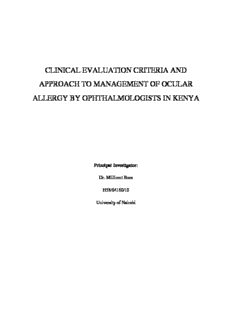
Clinical evaluation criteria and approach to management of ocular allergy by ophthalmologists in ... PDF
Preview Clinical evaluation criteria and approach to management of ocular allergy by ophthalmologists in ...
CLINICAL EVALUATION CRITERIA AND APPROACH TO MANAGEMENT OF OCULAR ALLERGY BY OPHTHALMOLOGISTS IN KENYA Principal Investigator: Dr. Millicent Bore H58/64160/10 University of Nairobi i ii DEDICATION This work is dedicated to my family for their continued support and encouragement in my every endeavour. iii ACKNOWLEDGEMENTS I wish to acknowledge the contributions of the following individuals and group to the development of this research paper: 1. Prof. Ilako, Dr. Kariuki, and J.M Nzinga for their contributed ideas, feedback and advice during the entire study period. 2. Carol Gitonga for data analysis and Sarah Osano for assistance in preparation of the thesis. 3. My sponsors, Lions of Bavaria, for the financial support towards the budget of the study. 4. All the ophthalmologists who participated in the study for taking time to do so. 5. Kikuyu Eye Unit and the departments of ophthalmology at the University of Nairobi And Kenyatta National Hospital for taking part in the focus group discussions. 6. My friends, who made available their support in a number of ways. iv TABLE OF CONTENTS DECLARATION ............................................................................................................................. i APPROVAL ................................................................................................................................... ii ACKNOWLEDGEMENTS ........................................................................................................... iv LIST OF TABLES ........................................................................................................................ vii LIST OF ABBREVIATIONS ...................................................................................................... viii ABSTRACT .................................................................................................................................... x 1. INTRODUCTION TO OCULAR ALLERGY ....................................................................... 1 1.1 DEFINITION ................................................................................................................... 1 1.2 EPIDEMIOLOGY ............................................................................................................ 1 1.3 PATHOLOGY ................................................................................................................. 2 2. LITERATURE REVIEW ........................................................................................................ 3 2.1 CLASSIFICATION ......................................................................................................... 3 2.1 DIAGNOSIS .................................................................................................................... 3 2.2 EVALUATION OF GRADE OF SEVERITY FOR OCULAR ALLERGY ................... 4 2.3 MANAGEMENT ............................................................................................................. 5 2.4 STANDARD TREATMENT GUIDELINES .................................................................. 8 2.5 LITERATURE REVIEW SUMMARY ........................................................................... 8 3. JUSTIFICATION .................................................................................................................... 9 4. STUDY OBJECTIVES ........................................................................................................... 9 4.1 Broad Objectives: ............................................................................................................. 9 4.2 Specific Objectives: .......................................................................................................... 9 5. METHODOLOGY ................................................................................................................ 10 5.1 Study design ................................................................................................................... 10 5.2 Study area ....................................................................................................................... 10 5.3 Study population ............................................................................................................ 10 5.4 Study period ................................................................................................................... 10 5.5 Sampling size ................................................................................................................. 10 5.6 Sampling method ............................................................................................................ 11 5.7 Inclusion criteria ............................................................................................................. 11 v 5.8 Exclusion criteria ............................................................................................................ 11 5.9 Tools ............................................................................................................................... 11 5.10 Ethical Considerations .................................................................................................... 12 5.11 Procedure ........................................................................................................................ 12 6. RESULTS .............................................................................................................................. 17 7. DISCUSSION ........................................................................................................................ 41 8. CONCLUSION ..................................................................................................................... 47 9. RECOMMENDATIONS....................................................................................................... 48 10. LIMITATIONS ...................................................................................................................... 49 11. APPENDICES ....................................................................................................................... 50 11.1 APPENDIX I: Approval letter from Ethics and Research Committee .......................... 50 11.2 APPENDIX 11: Information Sheet ................................................................................ 52 11.3 APPENDIX III: Questionnaire....................................................................................... 53 11.4 APPENDIX IV: FGD Consent Form ............................................................................ 56 11.5 APPENDIX V: Discussion Guide .................................................................................. 57 11.6 APPENDIX VI: Studies on Evaluation of Grade of Severity for Ocular Allergy ......... 61 12. REFERENCES .................................................................................................................. 67 vi LIST OF FIGURES Figure 1: Flowchart for online survey participants ....................................................................... 17 Figure 2: Flowchart showing respondents not grading OA .......................................................... 21 Figure 3: Perceived importance of grading OA ............................................................................ 22 Figure 4: Perceived importance of symptoms in the grading of ocular allergy severity .............. 24 Figure 5: Perceived importance of signs in the grading ocular allergy severity ........................... 26 Figure 6: Important factors in the selection of treatment offered ................................................. 28 Figure 7: FGD participants’ flowchart .......................................................................................... 30 LIST OF TABLES Table 1: Characteristics of the study participants ......................................................................... 18 Table 3: Important symptoms and signs for diagnosis of ocular allergies ................................... 19 Table 3: Classification and grading of ocular allergies ................................................................ 20 Table 4: Perceived importance of symptoms in OA diagnosis ..................................................... 23 Table 5: Perceived importance of signs for grading severity of OA ............................................ 25 Table 6: Factors of importance in treatment selection .................................................................. 27 Table 7: Mode of treatment and category used ............................................................................. 29 Table 8: Mild ocular allergy ......................................................................................................... 33 Table 9: Moderate ocular allergy .................................................................................................. 34 Table 10: Severe ocular allergy .................................................................................................... 35 vii LIST OF ABBREVIATIONS AKC- Atopic Keratoconjunctivitis AOD-Allergic Ocular Diseases CsA- Cyclosporine A EACO- Eastern Africa College of Ophthalmologists ENT- Ear Nose and Throat FGD- Focus Group Discussion GPC- Giant Papillary Conjunctivitis HDM- House Dust Mites KAP- Knowledge Attitude and Practice KEU- Kikuyu Eye Unit KNH- Kenyatta National Hospital MCJ- Mucocutaneous Junction MGD- Meibomian Gland Disease MMed- Master of Medicine NSAIDs- Non-Steroidal Anti-inflammatory Drugs OA- Ocular Allergy OSEA- Ophthalmological Society of Eastern Africa PAC- Perennial Allergic Conjunctivitis SAC- Seasonal Allergic Conjunctivitis SPK- Superficial Punctate Keratitis viii STGs- Standard Treatment Guidelines UON- University of Nairobi VKC- Vernal Keratoconjunctivitis ix
Description: